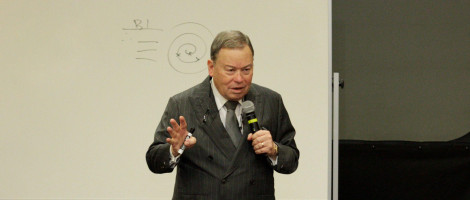Trying to separate preaching from persuasion is a false dichotomy, said Joel Gregory, professor of preaching at George W. Truett Seminary at Baylor University.
Persuasion has gotten a bad rap lately, often because it has become associated with manipulation or even coercion, but it doesn’t have to be a bad thing. It was almost a motto for Paul’s ministry, Gregory said.
Paul was always trying to persuade, from his first stop in each new town speaking to the Jews at the local synagogue to the Gentiles with his Areopagus address.
“When you seek to persuade, you’re preaching with a desire to change or reinforce attitude or behavior,” Gregory said. “Change if it needs to be modified, or reinforce if it’s good and there needs to be more of it.”
He described two distinct types of persuasive preaching and recommended that preachers keep their specific congregation in mind when deciding between the two.
The first is the direct sermon style.
“That is when the congregation is looking at the text while you preach,” he said. “How you’re seeking to persuade is directly related to the text. It’s on the surface. It’s not evocative or connotative. The text is denotative; it’s saying what you’re saying.”
Direct sermons are typically preferred by people over 50 who benefit from taking notes, as well as analytical personality types such as engineers or accountants. These sermons are easy to outline and follow a clear, linear thread.
“There’s many folks today who’d say that a direct style is too much in the face of the congregation,” Gregory said. “That has led to narrative and inductive preaching, which is not linear. It’s evocative or connotative. It’s indirect.”
Indirect sermons are preferred by those whose thinking is more like “looking down a spiral staircase from the top down,” Gregory said.
“They pick up a little bit from the device that’s in their hand, a little from what you’re preaching, snippets from a podcast and what they heard from a significant group of friends. This thinking is more of a spiral, indirect, evocative process. It’s just simply not linear thinking.”
He touched on the “ladder structure technique,” where the preacher starts with an easy point of agreement and builds upon it to lead the congregation to agree with tougher and tougher points as the sermon goes on.
He also talked about the importance of the speaker’s trustworthiness and expertise when trying to persuade.
“There are some fields where one is weightier than the other. If I have to have brain surgery, I’d like the brain surgeon to be a good guy, but I’d probably give expertise the edge,” he said. “I don’t think preaching works that way. If you lose either one of these, it diminishes your ability to persuade.”
He finished his talk with a reminder that the outcome of a sermon is often out of the preacher’s hands.
“When I talk about techniques in preaching, someone wants to know, ‘What is your part and what is God’s part?’ No amount of technique can substitute for what He may do in that moment of preaching. In that regard, you do not control preaching.”
He recalled his family’s first barbecue grill. As a boy he’d watch his father stack up charcoal, douse it in lighter fluid and toss in a match. Sometimes fire would leap to the eaves of the house. Other times, it would sputter and die.
“The whole process was unpredictable,” he said. “There’s a sense that preaching is like that. You can study. You can pray and say, ‘Lord, anoint this.’ But there’s something about that hour when you stand up to throw the match in that you don’t control. That’s a good reminder of Who preaching really belongs to.”
Texas Baptists is a movement of God’s people to share Christ and show love by strengthening churches and ministers, engaging culture and connecting the nations to Jesus.
The ministry of the convention is made possible by giving through the Texas Baptists Cooperative Program, Mary Hill Davis Offering® for Texas Missions, Texas Baptists Worldwide and Texas Baptist Missions Foundation. Thank you for your faithful and generous support.
Subscribe to receive stories like this one directly to your inbox.
We are more together.
Read more articles in: News, Annual Meeting
More from Lauren Hollon Sturdy
- Challenging Texas Baptists to change the world by looking up
- Mancini challenges churches to dream big
- Robert Pinder, Bob Feather and First Baptist Belton honored by Texas Baptist Mission Foundation
- Cross-cultural, cross-generational communication in Hispanic churches
- Hispanic Baptists worship, emphasize being compelled to action





